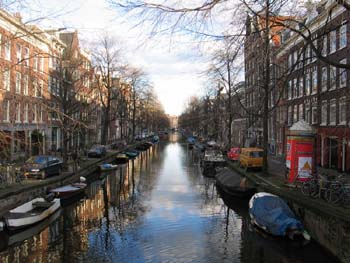11.07.2005 15:19
 The State Hermitage Museum in St. Petersburg, which has one of the world's largest collections of art, announced a 39-million-euro (US$46.5 million) expansion of its small branch in downtown Amsterdam.
The State Hermitage Museum in St. Petersburg, which has one of the world's largest collections of art, announced a 39-million-euro (US$46.5 million) expansion of its small branch in downtown Amsterdam.
The Hermitage will occupy the rest of the Amstelhof building, built in the 1680s by the Dutch Reformed Church as a home for the elderly. After the last residents are moved out at the end of 2006, the Hermitage will increase its space in the Amstelhof tenfold to almost 10,000 square meters.
The announcement of the expansion was timed with Russian President Vladimir Putin's visit to Amsterdam on Nov. 1 and 2, the first by a Russian head of state since Peter the Great in 1697. Trade between the Netherlands and Russia totaled US$15 billion in the first seven months of 2005.
The branch, which may attract as many as 300,000 visitors annually, will be self-financing, the Hermitage said. It is expected to earn 50 percent of its approximate 5-million-euro annual budget through ticket and concession sales and the other half from private sponsors. Exhibitions will rotate every six months. Entry costs six euros.
"Since no more than five percent of the Hermitage's total collection is on public display projects such as Amstelhof are important to help us bring our art works to a larger audience throughout the world," said Svetlana Philippova, the Hermitage liaison officer for the Amsterdam branch.
The Hermitage's collection, founded by Catherine the Great in the 1760s, numbers about 3 million items. About one- third of that is coins and medals, while the rest includes ancient Greek and Scythian gold, a fine collection of Rembrandt and other Dutch and Flemish masters as well as French impressionist and post-impressionist painters.
Dutch city, regional and national governments, as well as the Bank Giro Loterij, will finance the reconstruction of the Amstelhof. The repairs will alter the interior, removing the narrow corridors and small rooms to create several spacious, light-filled exhibition halls. Work will begin in early 2007, and is scheduled to be completed at the end of 2008.
The Hermitage also has outposts in London and Kazan, the capital of Russia's Tatarstan republic, and plans to expand into more countries, such as Italy, over the next decade.
The idea of such branches began with Amsterdam. In 1999, Hermitage Director Mikhail Piotrovsky and Ernst Veen, then director of Amsterdam's Stichting De Nieuwe Kerk exhibition hall, hatched the idea of an outpost in the Dutch capital. The first rooms of the Amsterdam branch, of which Veen is now director, opened in February 2004.
Besides giving the Hermitage more space, opening branches abroad has public-relations value.
"Many people in Europe still don't know much about the Hermitage and Russia," said Philippova. "Such branches increase the prestige and influence of the museum, as well as help create a positive image for all of Russia."
News source: chinapost.com.tw
 Print this news Print this news
Culture news archive for 07 November' 2005.
Culture news archive for November' 2005.
Culture news archive for 2005 year.
|